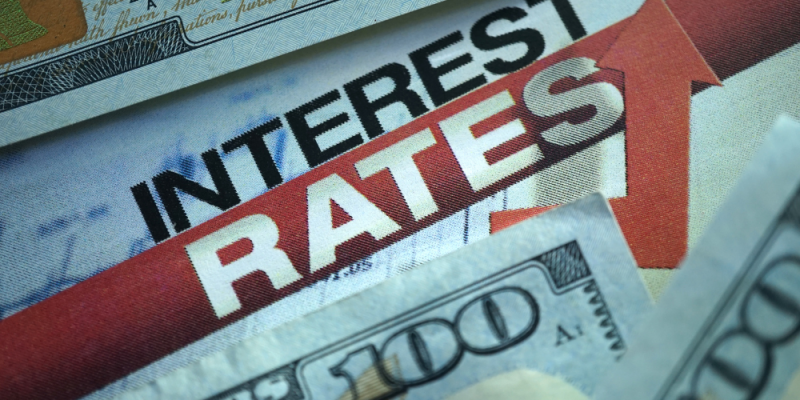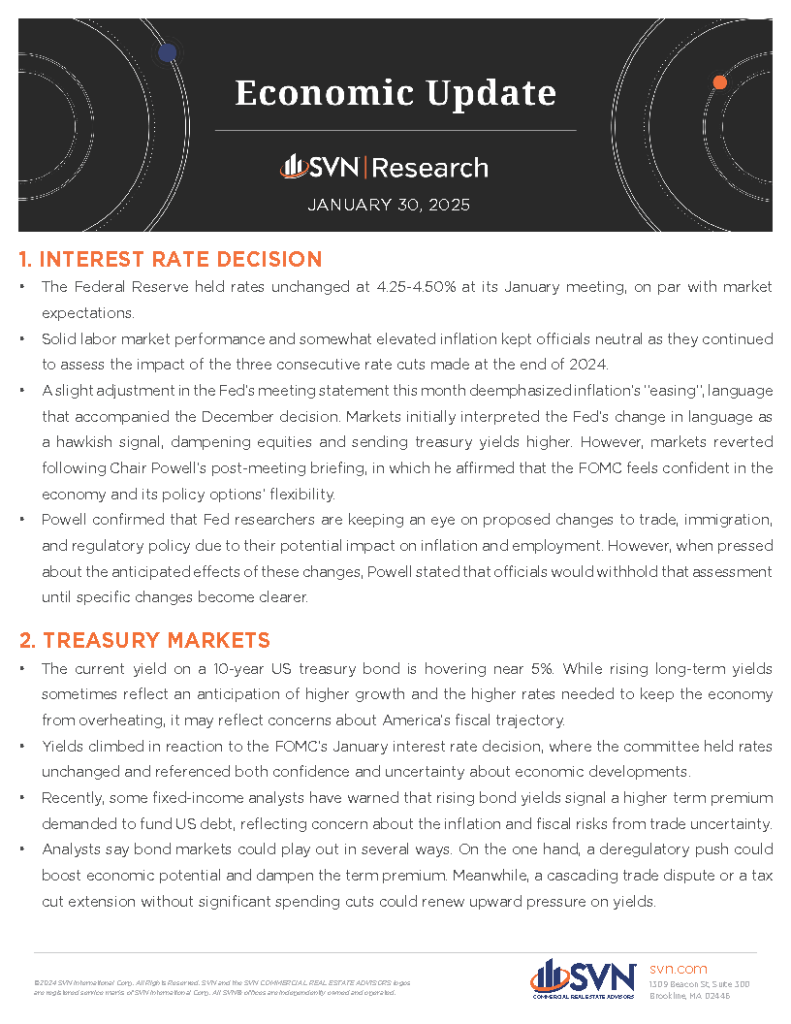1. INTEREST RATE DECISION
- The Federal Reserve held rates unchanged at 4.25-4.50% at its January meeting, on par with market expectations.
- Solid labor market performance and somewhat elevated inflation kept officials neutral as they continued to assess the impact of the three consecutive rate cuts made at the end of 2024.
- A slight adjustment in the Fed’s meeting statement this month deemphasized inflation’s “easing”, language that accompanied the December decision. Markets initially interpreted the Fed’s change in language as a hawkish signal, dampening equities and sending treasury yields higher. However, markets reverted following Chair Powell’s post-meeting briefing, in which he affirmed that the FOMC feels confident in the economy and its policy options’ flexibility.
- Powell confirmed that Fed researchers are keeping an eye on proposed changes to trade, immigration, and regulatory policy due to their potential impact on inflation and employment. However, when pressed about the anticipated effects of these changes, Powell stated that officials would withhold that assessment until specific changes become clearer.

Image Credit: Kameleon007 from Getty Images Signature
2. TREASURY MARKETS
- The current yield on a 10-year US treasury bond is hovering near 5%. While rising long-term yields sometimes reflect an anticipation of higher growth and the higher rates needed to keep the economy from overheating, it may reflect concerns about America’s fiscal trajectory.
- Yields climbed in reaction to the FOMC’s January interest rate decision, where the committee held rates unchanged and referenced both confidence and uncertainty about economic developments.
- Recently, some fixed-income analysts have warned that rising bond yields signal a higher term premium demanded to fund US debt, reflecting concern about the inflation and fiscal risks from trade uncertainty.
- Analysts say bond markets could play out in several ways. On the one hand, a deregulatory push could boost economic potential and dampen the term premium.
- Meanwhile, a cascading trade dispute or a tax cut extension without significant spending cuts could renew upward pressure on yields.
3. THE AI RACE AND DATA CENTER DEMAND
- A shocking AI advancement by Chinese company DeepSeek upended the US tech market this week as investors reassess the dominance of US tech firms in the AI race. It also sparked debate about domestic data center demand.
- Data centers have garnered increased attention in recent years as the AI race takes off due to the nascent technology’s high electricity demand. According to the investment bank Jefferies, projected AI needs represent 75% of the overall US electricity demand through 2035 in most forecasts.
- However, DeepSeek raised the stakes for US AI firms after building a generative AI model with significantly less hardware and energy, challenging the energy-demand thesis driving data center development. US utility firms dependent on data center demand also saw their stock prices take a hit following the DeepSeek news.
- Nonetheless, a more competitive AI space would likely create down-the-road opportunities for data centers. As AI infrastructure becomes cheaper to build and AI applications become easier to produce, it could funnel new capital into startups and widen the customer base for data center providers.
4. BUSINESS UNCERTAINTY
- • According to the Atlanta Federal Reserve’s January 2025 Survey of Business Uncertainty, sales revenue growth expectations have risen in recent months but remain more uncertain compared to pre-pandemic averages.
- The survey, which polls about 1500 senior managers at US firms monthly, shows that year-ahead sales growth expectations are the highest since the end of 2022. Additionally, expected employment growth has improved recently, while uncertainty surrounding employment growth has returned to pre-pandemic levels.
- Sales uncertainty has fallen but remains high by historical standards. As of January 2025, year-ahead sales growth uncertainty is at its lowest since 2020 but continues to hover close to around 4% compared to a pre-pandemic coalescing around 3%.
5. CONSUMER CONFIDENCE
• US consumer confidence fell at the start of the year, according to the latest reading from the Conference Board.
• While some deterioration was expected following a holiday season bump, the index, which measures American’s assessment of both current conditions and their six-month outlook, fell steeper than most economists expected.
• The current conditions index tumbled 9.7 points in January, while the more narrowly scoped labor market conditions index fell for the first time since September.
• American’s short-term expectations for income, business, and the job market also fell. However, anticipation of a recession over the next 12 months remained relatively low.
6. RETAIL SALES
- US retail sales were up 0.4% month-over-month in December, according to the latest data from the Census Bureau.
- The reading reflects some added momentum to consumer activity to close 2024 and prompted some economists to revise up their growth forecasts for 2025.
- While the holiday season contributed to the uptick, sales rose 4.2% from December 2023. According to the retail trade report, strong demand for motor vehicles and non-store retailers helped drive the increase, with sales up 8.4% year-over-year and 6.0% year-over-year, respectively.
- Strong retail data also likely contributes to the Fed’s caution around rate cuts as they monitor demand indicators to prevent an inflation resurgence.

Image Credit: Monkey Business Images via Canva
7. LOGISTICS PROPERTY RENTS DROP
- According to new data from Prologis, rent growth for US logistics properties turned negative in 2024, the first drop in 15 years.
- Rents in the US and Canada fell by 7% on average, steeper than the 5% decline experienced globally. The decline was partly led by slower growth in markets with recently high competition rates, such as Phoenix.
- US logistics rents are still up 59% compared to 2019, leaving most inventors well positioned, while lower rents could entice new tenants looking to scoop up cheap space in the high-demand sector.
8. INDEPENDENT LANDLORD RENTAL PERFORMANCE
- According to the Chandan Economics-RentRedi Independent Landlord Rental Performance report, the on-time payment rate in independently operated rental units slipped by 70 basis points (bps) in January and is down 112 bps year-over-year, falling to 85.0%.
- On-time collections had stabilized for the latter half of 2024, holding between 85.4% and 85.8% from July through December. January’s estimate signals some deterioration in tenant payments—as it currently stands, this month’s on-time collection rate is the lowest on record since April 2021.
- Western states continue to hold the highest on-time payment rates in the country, led by Idaho, Utah, Nevada, North Dakota, and Colorado.
- Meanwhile, 2-4-family and single-family rental properties held the highest on-time payment rates in January, reaching 85.2%.
9. BEIGE BOOK
- According to the Federal Reserve’s latest Beige Book, economic activity increased “slightly” to “moderately” in most regions between late November and early December, driven by higher-than-expected consumer holiday spending.
- Construction activity generally declined as producers reported high materials and financing costs that dampened business expansion. Residential real estate activity was on balance unchanged as elevated mortgage rates kept demand at bay. Commercial real estate sales ticked up.
- Manufacturing declined slightly, with many manufacturers reportedly stockpiling inventories in anticipation of higher tariffs. Meanwhile, truck freight volumes fell.
10. NEW HOME SALES
- Sales of newly built single-family homes jumped by 3.6% in December to a seasonally adjusted annualized rate of 698k, the highest increase since September and well above market expectations.
- Sales growth was sustained despite a surge in mortgage rates during the month. The West region of the US led by volume, selling at an annualized rate of 154k units per year. The West was followed by the Northeast, with an annualized rate that would amount to a 41.7% increase. Sales rates in the South and Midwest fell.
- The median price of a newly built single-family home was $427k, up from $402k in December.

